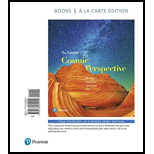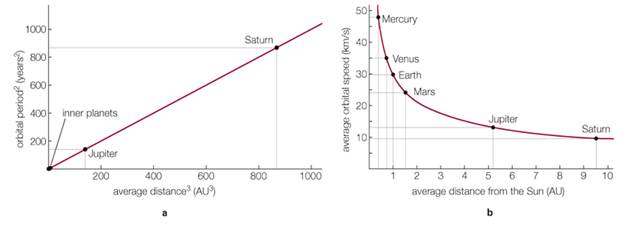
Essential Cosmic Perspective, The, Books a la Carte Edition (8th Edition)
8th Edition
ISBN: 9780134532455
Author: Jeffrey O. Bennett, Megan O. Donahue, Nicholas Schneider, Mark Voit
Publisher: PEARSON
expand_more
expand_more
format_list_bulleted
Textbook Question
Chapter 3, Problem 3VSC
Use the information in the graphs to answer the following questions.
Check your understanding of some of the many types of visual information used in astronomy. For additional practice, try the Chapter 3  Visual Quiz at Mastering Astronomy.
Visual Quiz at Mastering Astronomy.

3. Uranus, not shown on the graph, orbits about 19 AU from the Sun. Based on the graph, its approximate orbital speed is between about _______.
a. 20 and 25 km/s
b. l5 and 20 km/s
c. 10 and l5 km/s
d. 5 and 10 km/s
Expert Solution & Answer
Want to see the full answer?
Check out a sample textbook solution
Students have asked these similar questions
3
13.
After a gust of wind, an orb weaver spider with a mass of 35 g, hanging on a strand of web of length L = .420 m, undergoes simple harmonic motion (SHO) with an amplitude A and period T.
If the spider climbs 12.0 cm up the web without perturbing the oscillation otherwise, what is the period of oscillation, in Hz to three significant figures?
15.
An object of mass m = 8.10 kg is attached to an ideal spring and allowed to hang in the earth's gravitational field. The spring stretches 23.10 cm before it reaches its equilibrium position. The mass then undergoes simple harmonic motion with an amplitude of 10.5 cm.
Calculate the velocity of the mass in m/s at a time t= 1.00s to three significant figures.
Chapter 3 Solutions
Essential Cosmic Perspective, The, Books a la Carte Edition (8th Edition)
Ch. 3 - Prob. 1VSCCh. 3 - Use the information in the graphs to answer the...Ch. 3 - Use the information in the graphs to answer the...Ch. 3 - Use the information in the graphs to answer the...Ch. 3 - Use the information in the graphs to answer the...Ch. 3 - Use the information in the graphs to answer the...Ch. 3 - Use the information in the graphs to answer the...Ch. 3 - In what way is scientific thinking natural to all...Ch. 3 - Prob. 2EAPCh. 3 - What is a lunar calendar? How can it be kept...
Ch. 3 - What do we mean by a model in science? Briefly...Ch. 3 - What do we mean by the Ptolemaic model? How did...Ch. 3 - What was the Copernican revolution, and how did it...Ch. 3 - What is an ellipse? Define its foci, semimajor...Ch. 3 - State and explain the meaning of each of Kepler’s...Ch. 3 - Describe the three hallmarks of science and...Ch. 3 - What is the difference between a hypothesis and a...Ch. 3 - Each of the following statements makes some type...Ch. 3 - Each of the following statements makes some type...Ch. 3 - Each of the following statements makes some type...Ch. 3 - Each of the following statements makes some type...Ch. 3 - Each of the following statements makes some type...Ch. 3 - Each of the following statements makes some type...Ch. 3 - Each of the following statements makes some type...Ch. 3 - Each of the following statements makes some type...Ch. 3 - Each of the following statements makes some type...Ch. 3 - Prob. 20EAPCh. 3 - Choose the best answer to each of the following....Ch. 3 - Choose the best answer to each of the following....Ch. 3 - Choose the best answer to each of the following....Ch. 3 - Choose the best answer to each of the following....Ch. 3 - Choose the best answer to each of the following....Ch. 3 - Choose the best answer to each of the following....Ch. 3 - Choose the best answer to each of the following....Ch. 3 - Choose the best answer to each of the following....Ch. 3 - Choose the best answer to each of the following....Ch. 3 - Choose the best answer to each of the following....Ch. 3 - Prob. 31EAPCh. 3 - Earth’s Shape. It took thousands of years for...Ch. 3 - Prob. 33EAPCh. 3 - Prob. 34EAPCh. 3 - Prob. 35EAPCh. 3 - Prob. 36EAPCh. 3 - Prob. 37EAPCh. 3 - Prob. 38EAPCh. 3 - Halley Orbit. Halley’s comet orbits the Sun every...Ch. 3 - Prob. 40EAPCh. 3 - 41. The Importance of Ancient Astronomy. Why was...Ch. 3 - Prob. 42EAPCh. 3 - Prob. 43EAPCh. 3 - The Galileo Affair. In recent years. the Roman...Ch. 3 - Prob. 45EAPCh. 3 - Prob. 46EAP
Knowledge Booster
Learn more about
Need a deep-dive on the concept behind this application? Look no further. Learn more about this topic, physics and related others by exploring similar questions and additional content below.Similar questions
- please solve and answer the question correctly. Thank you!!arrow_forward18arrow_forward1. Some 1800 years ago Roman soldiers effectively used slings as deadly weapons. The length of these slings averaged about 81 cm and the lead shot that they used weighed about 30 grams. If in the wind up to a release, the shot rotated around the Roman slinger with a period of .14 seconds. Find the maximum acceleration of the shot before being released in m/s^2 and report it to two significant figures.arrow_forward
- 16arrow_forward11. A small charged plastic ball is vertically above another charged small ball in a frictionless test tube as shown in the figure. The balls are in equilibrium at a distance d= 2.0 cm apart. If the charge on one ball is tripled, find the new equilibrium distance between the balls in cm and report it to the proper number of significant figures.arrow_forward12. The electric field at a point 1.3 cm from a small object points toward the object with a strength of 180,000 N/C. Find the object's charge q, in nC to the proper number of significant figures. k = 1/4πε0 = 8.99 × 10^9 N ∙ m^2/C^2arrow_forward
- 14. When the potential difference between the plates of an ideal air-filled parallel plate capacitor is 35 V, the electric field between the plates has a strength of 670 V/m. If the plate area is 4.0 × 10^-2 m^2, what is the capacitance of this capacitor in pF? (ε0 = 8.85 × 10^-12 C^2/N ∙ m^2)arrow_forward10. A small styrofoam ball of mass 0.500 g is placed in an electric field of 1140 N/C pointing downward. What excess charge must be placed on the ball for it to remain suspended in the field? Report your answer in micro-Coulombs to three significant figures.arrow_forward2arrow_forward
arrow_back_ios
SEE MORE QUESTIONS
arrow_forward_ios
Recommended textbooks for you
 Glencoe Physics: Principles and Problems, Student...PhysicsISBN:9780078807213Author:Paul W. ZitzewitzPublisher:Glencoe/McGraw-Hill
Glencoe Physics: Principles and Problems, Student...PhysicsISBN:9780078807213Author:Paul W. ZitzewitzPublisher:Glencoe/McGraw-Hill Horizons: Exploring the Universe (MindTap Course ...PhysicsISBN:9781305960961Author:Michael A. Seeds, Dana BackmanPublisher:Cengage Learning
Horizons: Exploring the Universe (MindTap Course ...PhysicsISBN:9781305960961Author:Michael A. Seeds, Dana BackmanPublisher:Cengage Learning AstronomyPhysicsISBN:9781938168284Author:Andrew Fraknoi; David Morrison; Sidney C. WolffPublisher:OpenStax
AstronomyPhysicsISBN:9781938168284Author:Andrew Fraknoi; David Morrison; Sidney C. WolffPublisher:OpenStax Foundations of Astronomy (MindTap Course List)PhysicsISBN:9781337399920Author:Michael A. Seeds, Dana BackmanPublisher:Cengage Learning
Foundations of Astronomy (MindTap Course List)PhysicsISBN:9781337399920Author:Michael A. Seeds, Dana BackmanPublisher:Cengage Learning Stars and Galaxies (MindTap Course List)PhysicsISBN:9781337399944Author:Michael A. SeedsPublisher:Cengage Learning
Stars and Galaxies (MindTap Course List)PhysicsISBN:9781337399944Author:Michael A. SeedsPublisher:Cengage Learning

Glencoe Physics: Principles and Problems, Student...
Physics
ISBN:9780078807213
Author:Paul W. Zitzewitz
Publisher:Glencoe/McGraw-Hill

Horizons: Exploring the Universe (MindTap Course ...
Physics
ISBN:9781305960961
Author:Michael A. Seeds, Dana Backman
Publisher:Cengage Learning

Astronomy
Physics
ISBN:9781938168284
Author:Andrew Fraknoi; David Morrison; Sidney C. Wolff
Publisher:OpenStax

Foundations of Astronomy (MindTap Course List)
Physics
ISBN:9781337399920
Author:Michael A. Seeds, Dana Backman
Publisher:Cengage Learning

Stars and Galaxies (MindTap Course List)
Physics
ISBN:9781337399944
Author:Michael A. Seeds
Publisher:Cengage Learning

Kepler's Three Laws Explained; Author: PhysicsHigh;https://www.youtube.com/watch?v=kyR6EO_RMKE;License: Standard YouTube License, CC-BY